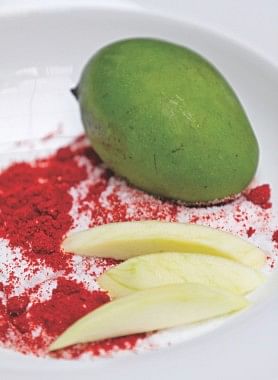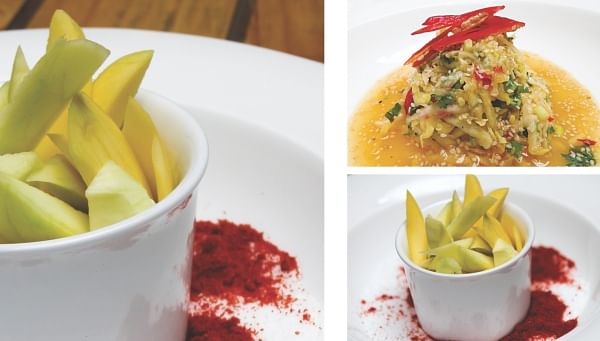Boishakhi delights Green Mango
 In the bygone days, there used to be large mango tree in front of our tin-shed house. Bigger than the trees we had in the backyard, it was a landmark of our dwelling -- “the house with the mango tree.” We played cricket with the trunk of the tree as a wicket and the wide lawn, our very-own outfield.
In the bygone days, there used to be large mango tree in front of our tin-shed house. Bigger than the trees we had in the backyard, it was a landmark of our dwelling -- “the house with the mango tree.” We played cricket with the trunk of the tree as a wicket and the wide lawn, our very-own outfield.
The large fruits that the tree bore every Boishakh, had a distinct taste when raw and green, but lost flavours as it matured into ripe, yellow-green mangoes. “Kacha-mitha”, my grandmother used to say. And that unique fragrance was unmatched.
Even my grandmother could not say who planted the tree, but judging by its size, it must have been many decades ago; probably before my great grandfather built the tin house. The fruit was sweet enough to be bitten off without any need of peeling the skin. The outer skin had no caustic sap and the juice that drained out with every bite sent a concoction of two opposite sensations in the tongue, a little sour and a little sweet.
The trees that lined the backward were indistinct. They were less productive, bearing few fruits. And their taste, nothing worth noting. Jamini khala, our cook, would collect raw mangoes using a long pole with a twig firmly pinned to the bamboo-stick. Those, we were told, were for pickles and lentils.
Clichéd as it may sound today, those really were the days of our childhood, as every adult can recall. The proverbial 'picking mangoes in the Boishakhi storm' were realities for us, not something read out from a nineteenth century Bengali novel. Yet, even for those not fortunate enough to experience a Kal-Boishakhi under a giant mango tree, the green mango holds a special place.
The boon of the season is found in superstores, bazaars, along the pavements. Everywhere! Posh eateries serve chilled, mango juice spiked with slight hints of green chillies. And quite frankly, they make a delightful drink.
It replenishes not only the water lost in the summer heat, but also serve as a good supply of mineral and vitamins. Served with crushed ice, they are undoubtedly a seasonal favourite.
And speaking of favourites, 'aam daal' (lentil soup with chunks of green mangoes) rate high in the list. It adds to the variation on the dinner table and does wonders for the taste buds. In many a household, this is a summer staple. Teemed with a dash of green-chillies, or some portions of 'naga morich' for those who dare, lentils with mangoes simply 'goes!'
Pickled. Some prefer and the options are wide. From Kashmiri variants to unknown recipes handed down from one generation to the next for eons. Every household has a special formula and every grandmother has secrets up her sleeves. Made by their magical hands, these are enchantments 'pickled in glass jars'.
 Before the mango can be put in oil, it is important that the chunks are drained of their water content by drying in the open sun. Rubbed with a little turmeric, these dried pieces make another delightful summer experience the 'bhorta' (mashed mangoes).
Before the mango can be put in oil, it is important that the chunks are drained of their water content by drying in the open sun. Rubbed with a little turmeric, these dried pieces make another delightful summer experience the 'bhorta' (mashed mangoes).
True, some would argue that the best 'bhorta' is made from succulent greens, but no one can deny the appeal of the dried variants either. Once again teemed with green chillies, they make wonderful chutneys. Mixed with mustard sauce (kashundi), mango bhorta is a delightful Bengali experience.
However, the delight that is mango is no longer a fruit of the tropical and subtropical climates; they are now cultured across the world and ripe mangoes are a favourite the world over. Cultures have also adapted to the delightful taste of raw mangoes. From appetiser, to salad, to main course, to drink, the green mango has proved to be quite versatile.
Photo: Sazzad Ibne Sayed
Food prepared by Cilantro

 For all latest news, follow The Daily Star's Google News channel.
For all latest news, follow The Daily Star's Google News channel. 



Comments